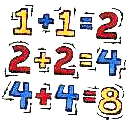Combining Like Terms and The Distributive Property
Students will learn how to use the distributive property to combine like terms.
Objectives:
• Students will learn the steps to combining like terms using the distributive property.
• Students will practice combining like terms using the distributive property.
Suggested Grades:
Sixth Grade - Seventh Grade - Eighth Grade - Ninth Grade - including special education students
Print the classroom lesson plan and worksheet questions (see below).
Lesson Excerpt:
I. Introduction and Review
- "Today we are going to continue combining like terms, but this time we are going to incorporate the distributive property into our work."
- "But before we begin, let's just take a minute to review. What are a few of the rules we need to remember when we are combining like terms?"
- Encourage student participation during this part. If there aren't any student volunteers, prompt students to refer back to the notes in their notebooks. Then students will be able to participate. Write their contributions on the board and fill in any that they miss.
- On Board: the number in front of the term can be different, but the letters associated with the term must be exactly the same.
- The number connected with the term can be positive or negative.
- Combining Like Terms involves addition and subtraction.
- Always pay attention to the sign in front of each term to tell you which operation to perform when combining like terms.
- "Good, now let's take a minute to talk about the distributive property."
- "We use the distributive property to simplify an expression. We distribute/multiply a number outside of the parentheses by both of the terms inside the parentheses. Here is an example:"
Continued...

Lesson Printables:
Print this printable worksheet for this lesson:


